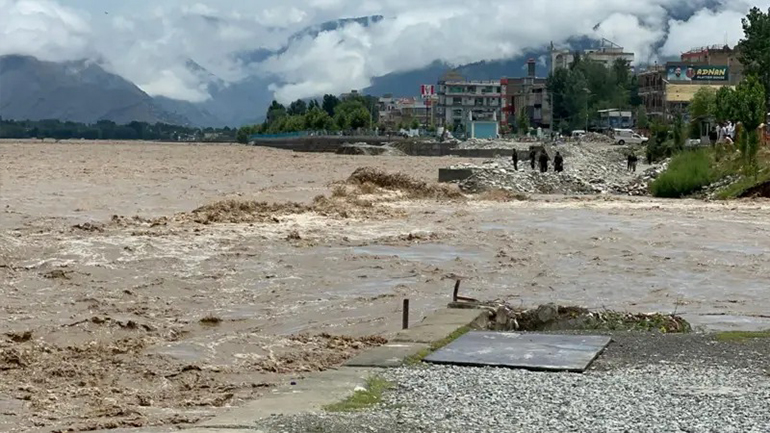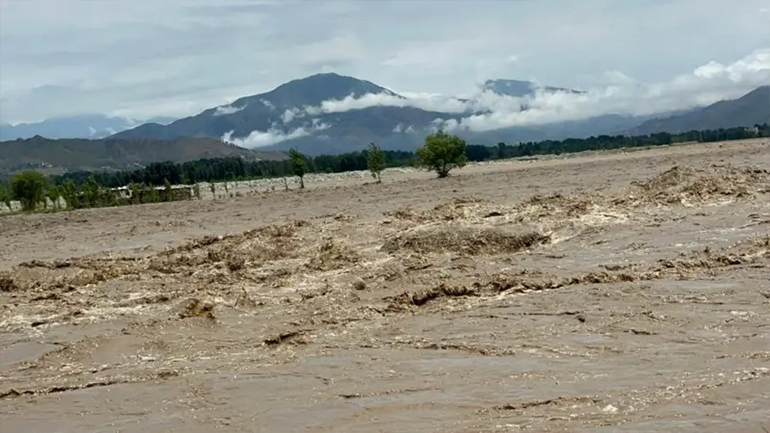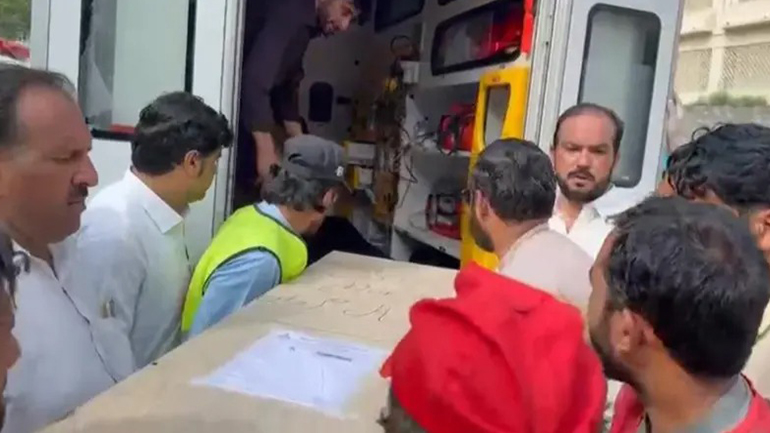

These are the words of eyewitnesses who watched helplessly as a group of tourists drowned in the Swat River. The victims were visiting Swat and other northern hill stations for leisure when tragedy struck. Fazal Wahid, a resident who lives near the riverbank, said, "When I arrived at the scene, there were many people around, but no one dared to jump in and save them. We called the rescue team, but they arrived very late." Following the incident, authorities have launched a public awareness campaign, urging people to maintain a safe distance from rivers and observe all safety precautions during tourist activities. Emergency services are now being equipped with life jackets and other rescue equipment, and illegal structures and encroachments along riversides are being removed to ensure better access and safety for future emergencies.
Swat remains in mourning. The atmosphere is still somber following the tragic drowning incident. Local authorities have begun removing encroachments around hotels along the riverbanks, and steps are being taken to make the river safer for residents and tourists alike. Rescue agencies have launched public awareness campaigns, urging people to stay away from waterways and follow safety precautions, especially in popular tourist spots. The government has initiated an official inquiry into the incident, and so far, four officials have been suspended. However, the pressing question remains: Will these measures be sufficient to reassure the public that such incidents will not happen again? And even more importantly: Will the government be able to identify whether this tragedy was a result of negligence or incompetence—and will anyone be held accountable? investigated public sentiment in Swat, interviewed rescue officials, as well as representatives from the NDMA (National Disaster Management Authority) and the PDMA (Provincial Disaster Management Authority). The views of local hotel owners were also gathered to understand the broader impact and the response to the tragedy.

The tragic Swat River drowning incident has cast a shadow of grief across the region. While this is not the first time tourists have drowned in Swat, the recent tragedy gained widespread attention because it was captured on camera. On June 27, seventeen individuals — including children, women, and the elderly — were caught in the powerful current near a hotel on Swat Bypass Road. Ten of them were from Daska in Punjab, six from Mardan, and one from Swat. Eyewitness Fazal Wahid said it was a moment of complete helplessness, as people stood on the banks watching them being swept away by the flash floods in Swat, Pakistan. Although calls were made to emergency services, rescue efforts in Swat were delayed. Locals tried to help but lacked even basic equipment like ropes or life-saving tubes. The incident has sparked growing safety concerns, with many questioning the region’s disaster preparedness. Cameraman Khawaja Irfan, who was also present, said he still has nightmares about the scene. The emotional toll is immense, and locals feel deep remorse for not being able to save the flood victims in Swat. The incident has once again highlighted the urgent need for proper safety infrastructure, river safety in Pakistan, and better response systems to prevent future natural disasters in Swat.
This tragic incident occurred in the morning when tourists from Daska, Sialkot, stopped at a hotel along the Swat Bypass Road for breakfast. The tourists went near the flowing Swat River adjacent to the hotel and began taking photos and selfies. However, a flood warning had already been issued across Khyber Pakhtunkhwa, and Section 144 was in place, prohibiting public access to riverbanks. It appears these tourists, along with others, were unaware of the warnings. According to Swat City Mayor Shahid Ali Khan, the Irrigation Department had received early flood information from Khwazakhela and had informed the local administration. However, the communication remained limited to WhatsApp groups and emails — there was no physical presence of irrigation officials, local administration, or police near the river to warn or stop people. Hotel staff reportedly did not take concrete steps to prevent access either. A hotel owner, Dr. Amjad, claimed a guard had warned the group by shouting, “Come back, there’s a flood coming!” but the tourists responded that they just wanted to take a few more photos. When we visited the location, a protective wall was being constructed, and a temporary gravel-and-sand barrier had been built by a construction company to redirect the river’s flow. This barrier, located about 400–500 meters from the tourists, failed to withstand the force of the floodwater. A nearby hotel owner explained that on June 27, the floodwaters broke the temporary embankment, redirecting the river’s forceful flow toward the hotel area, where the water level was usually minimal. As a result, the tourists were trapped. According to Commissioner Malakand Abid Wazir’s inquiry report, the affected tourists from Sialkot arrived at the hotel at 8:31 AM and moved toward the river by 9:31 AM. A security guard attempted to stop them, but they had gone behind the hotel. The water level began to rise, and a rescue call was made at 9:45 AM — just 14 minutes after the tourists entered the river area. Rescue 1122 teams arrived at 10:05 AM. The report confirms that all relevant departments had already been alerted due to flood threats in Swat. Of the 17 stranded tourists, four were rescued, while twelve bodies were recovered. The government suspended the Deputy Commissioner, Additional Deputy Commissioner, Assistant Commissioners of Babuzai and Khwazakhela, along with the District Emergency Officer and Tehsil Municipal Officer of Swat, following the incident.
After the Swat River drowning incident, the District Emergency Officer was suspended, and Rafeeullah Marwat was appointed in his place. When asked about the Swat tourism tragedy, he said, "As soon as we received the alert, a rescue vehicle was dispatched within one minute and reached the site in about 10 to 12 minutes." He clarified that the initial emergency call mentioned children trapped in a hotel, but it was not known that they were stuck in the river floodwaters. "We had very little time. If we had just a bit more, those tourists in Swat could have been saved," he added. Rafeeullah Marwat admitted there is a need to improve rescue staff training and performance. He emphasized that modern equipment, emergency tools, and other disaster management resources are now being provided by the authorities. He further stated that a rescue drone would also be introduced to evaluate its effectiveness during harsh weather conditions and strong winds.
In the first six months of this year, 28 drowning incidents have already occurred in the region. Rescue 1122 driver Ismat Ali went out in a locally-made boat to save people stranded in the river. He explained that they had very limited time, saying, “The boat didn’t move straight. It had to be launched into the floodwater from a distance, and the current was so strong that controlling it was extremely difficult.” "When I boarded the boat, there were only six people visible at the site." Ismat Ali added that the boat was moving rapidly in the flood, and the only strategy was to try and stop it where the people were stranded. “As we approached, two people fell into the river, while three managed to grab the boat, and we brought them back to safety.” He remarked, “If we had more time, we could have saved everyone. But just a few meters away, a dam barrier broke, and the flash flood quickly reached the tourists.”

If you've ever traveled to the northern areas of Pakistan, you may have noticed that hotel owners often place traditional beds (charpoys) and chairs inside rivers or water streams for tourists to enjoy the experience. However, on the flip side, these hotel owners usually lack proper safety measures in case of a sudden flash flood or other emergencies. There are often no life jackets, ropes, or immediate rescue plans in place. Along the Swat River, hotel owners had also set up chairs and built stairs that led down to the river, yet local authorities took no action to prevent this or enforce any safety regulations. Recently, the provincial government demolished several riverside hotels that were reportedly built on encroached land, according to official documents. Hotel owners, however, have contested this, claiming that the land has belonged to their families for generations, and there is no illegal encroachment. They say they even possess court rulings in their favor. Dr. Amjad, a hotel owner, stated: “Hotels owned by influential people are being spared, while those with no political connections are being demolished.” Another owner, Rehmat Ali, said: “It’s a lie that we have encroached on the riverbank. Even after showing valid documents, our hotels were still torn down.” In response to a question, they admitted they had no life-saving equipment. “Even the rescue and government teams didn’t have anything when they arrived,” they said. Rehmat Ali added that they couldn’t stop people from going near the river. “When we tried, the committee told us not to interfere. We even installed a safety fence, but the committee removed it, accusing us of occupying the riverbank.”

Several government departments are responsible for managing tourist destinations in Khyber Pakhtunkhwa, including NDMA, PDMA, the district administration, the police, and the tourism police. Similarly, the Irrigation Department plays a key role, as it issues flood warnings. Then comes the responsibility of the Rescue 1122 emergency service. Residents questioned why, despite the flood alert and emergency declaration, none of these departments took immediate action. Swat City Mayor Shahid Ali Khan: “This was a collective responsibility. Every department had a role to play, and all of them failed. None fulfilled their duties.” According to Shahid Ali Khan, he had asked Rescue 1122 not to keep their vehicles stationed in just one place, but to also set up emergency stands along the riverbank. “Because it takes too long for a rescue vehicle to reach the river from the city,” he said. He added, “You can't simply stop tourists from going near the river. People come from far away to sit by the river, and instead of scaring them off, we need to ensure proper safety measures are in place to prevent such unfortunate incidents.” “Swat River isn't a problem in just one location—it is a hub of multiple issues,” he said. “The river’s width is inconsistent—narrow in some places, very wide in others. On one side, orchards and farmers try to occupy land near the banks, while on the other side, hoteliers try to divert the river to build hotels and earn higher profits.” He emphasized that “different departments have their own interests. But if there is sincere intent, the government can address these challenges effectively.”
Powered by Froala Editor